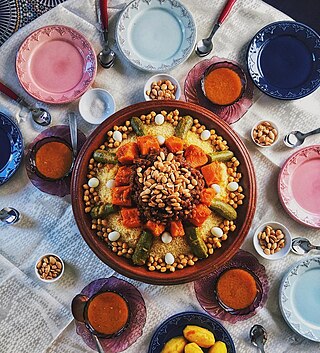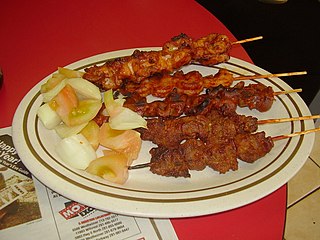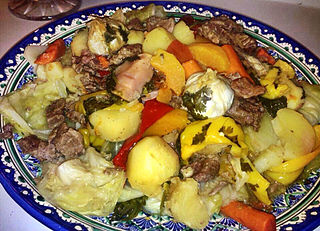Related Research Articles

Couscous is a traditional North African dish of small steamed granules of rolled semolina that is often served with a stew spooned on top. Pearl millet, sorghum, bulgur, and other cereals are sometimes cooked in a similar way in other regions, and the resulting dishes are also sometimes called couscous.

Idli or idly or iddali or iddena is a type of savoury rice cake, originating from South India, popular as a breakfast food in Southern India and in Sri Lanka. The cakes are made by steaming a batter consisting of fermented de-husked black lentils and rice. The fermentation process breaks down the starches so that they are more readily metabolised by the body.

Fried rice is a dish of cooked rice that has been stir-fried in a wok or a frying pan and is usually mixed with other ingredients such as eggs, vegetables, seafood, or meat. It is often eaten by itself or as an accompaniment to another dish. Fried rice is a popular component of East Asian, Southeast Asian and certain South Asian cuisines, as well as a staple national dish of Indonesia. As a homemade dish, fried rice is typically made with ingredients left over from other dishes, leading to countless variations. Fried rice first developed during the Sui dynasty in China.

Pilaf, pilav or pilau is a rice dish, usually sautéed, or in some regions, a wheat dish, whose recipe usually involves cooking in stock or broth, adding spices, and other ingredients such as vegetables or meat, and employing some technique for achieving cooked grains that do not adhere to each other.

Suya, also known as "Tsire" is a traditional smoked spiced meat skewer which originates from Nigeria, and is a popular food item across West Africa. Suya is a large part of Hausa culture and food and is traditionally prepared and made by Hausa men, thus called 'Mai tsire'. While suya is the more widely recognized name in many areas of Nigeria, the Hausa community still predominantly uses the original name, tsire. Suya is generally made with skewered beef, ram, or chicken. Organ meats such as kidney, liver and tripe are also used. The thinly sliced meat is marinated in various spices, which include traditional Hausa dehydrated peanut cookie called 'kwulikwuli', salt, vegetable oil and other spices and flavorings, and then barbecued. There are many variation of Suya in traditional Hausa cooking, but the most popular being suya. Suya is traditionally served with an extra helpings of mixed dried pepper, traditional hausa spices, and sliced onions. It is also traditionally served in Hausa culture with a side serving of Hausa Masa. Halal meat preparation methods are normally used, especially in the northern parts of Nigeria where it originates as is customary with traditional Hausa foods, where the suspicion of nonconformity to Muslim dietary prohibitions in Suya preparation has been known to cause riots. A dried version of Suya is called Kilishi. It can be eaten with Masa, Kosai, Garri or Ogi.

Jollof, or jollofrice, is a rice dish from West Africa. The dish is typically made with long-grain rice, tomatoes, chilis, onions, spices, and sometimes other vegetables and/or meat in a single pot, although its ingredients and preparation methods vary across different regions. The dish's origins are traced to Senegal.

Thoran (Malayalam: തോരൻ, pronounced ; or upperi in Northern Kerala is a class of dry vegetable dishes combined with coconut that originated in the Indian state of Kerala. This common dish is usually eaten with rice and curry and is also part of the traditional Keralite sadhya.

Akara is a type of fritter made from cowpeas or beans by the Yoruba people of Nigeria, Benin and Togo. It is found throughout West African, Caribbean, and Brazilian cuisines. The dish is traditionally encountered in Brazil's northeastern state of Bahia, especially in the city of Salvador. Acarajé serves as both a religious offering to the gods in the Candomblé religion and as street food. The dish was brought by enslaved Yoruba citizens from West Africa, and can still be found in various forms in Nigeria, Benin and Togo.

Uzbek cuisine shares the culinary traditions of peoples across Central Asia. Grain farming is widespread in Uzbekistan, making breads and noodles an important part of the cuisine, which has been described as "noodle-rich".

Afghan cuisine is influenced by Persian, Central Asian, and South Asian cuisines due to Afghanistan's close proximity and cultural ties. The cuisine is halal and mainly based on mutton, beef, poultry and fish with rice and Afghan bread. Accompanying these are common vegetables and dairy products, such as milk, yogurt, whey, and fresh and dried fruits such as apples, apricots, grapes, bananas, oranges, plums, pomegranates, sweet melons, and raisins. The diet of most Afghans revolves around rice-based dishes, while various forms of naan are consumed with most meals. Tea is generally consumed daily in large quantities, and is a major part of hospitality. The culinary specialties reflect the nation's ethnic and geographic diversity. The national dish of Afghanistan is Kabuli palaw, a rice dish cooked with raisins, carrots, nuts, and lamb or beef.

Shumai is a type of traditional Chinese dumpling made of ground pork. In Cantonese cuisine, it is usually served as a dim sum snack. In addition to accompanying the Chinese diaspora, variations of shumai are found in Japan and Southeast Asia, such as the Indonesian siomay. In Australia, it developed into dim sim.

Nigerian cuisine consists of dishes or food items from the hundreds of Native African ethnic groups that comprises Nigeria. Like other West African cuisines, it uses spices and herbs with palm oil or groundnut oil to create deeply flavored sauces and soups.

Tuwon Shinkafa is a type of Nigerian and Nigerien rice swallow from Niger and the northern part of Nigeria. It is a thick pudding prepared from a local rice that is soft and sticky, and is usually served with different types of soups like Miyar Kuka, Miyar Kubewa, and Miyar Taushe. Two variants made from maize and sorghum flour are called Tuwon Masara and Tuwon Dawa, respectively. In Ghana, Tuwon Shinkafa is called Omo Tuo.

Miyar Kuka or Miyan Kuka, also known as Luru soup, is a type of soup popular among West Africa’s Sahelian ethnic groups. The soup is made from powdered baobab leaves. It is usually served with Tuwo or Fufu. A seasonal variant of this soup is made using fresh mashed baobab leaves. This variant is only available during the rainy season when fresh baobab leaves are available.

Koko is a spicy millet porridge. It is a popular Nigerian and Ghanaian street food and commonly consumed as a breakfast meal. It can also be taken in late afternoon as snack. Koko is made from many grains including millet with a few local spices added to give it a particular taste and color. It is called Hausa koko in areas where it was introduced by Hausa-speaking people. In northern Ghana, the term 'Hausa koko' is not used. Instead, porridge made from millet is called 'za koko' in Dagbanli. Several types of porridge are made from corn, millet, and sorghum. Other types of porridge include koko talli/salli, zimbuli, among others. It is also common in the various communities in both countries.
Hausa cuisine is traditional and modern food prepared by Hausa people. It is based on the availability of raw food materials they can farm or provide from other places. Most times Hausa people depend purely on the farm products they have cultivated for food preparations. Hausa people have a meal that is common to most Zongo communities called Tuo Zaafi.

Dambu or dambou is a dish native to the Zarma and Songhai of Southwestern Niger made from cereals and Moringa. It is consumed at any time but mainly during festive occasions such as outdoorings and weddings. This dish is also common among the Dendi people of North Benin and other West African cities. It is also common in the Zongo Settlements where the Songhai and Zarma travel.
Miyar Zogale is an Hausa dish also known as morning soup. It is made with moringa leaf as the main ingredient, others include groundnut paste, grounded tomato, beef, cubes, daddawa and palm oil.
Gizdodo is a Yoruba delicacy made of gizzard and dodo (plantain); this is a side dish eaten at home or for special occasions.
Sinasir is a Nigerian delicacy made from rice popular amongst the northern region. The type of rice used are of two types: Cooked and soaked rice.
References
- ↑ "Pate is a traditional porridge type of food that is eaten". The Guardian Nigeria News - Nigeria and World News. 2022-02-17. Archived from the original on 2022-05-31. Retrieved 2022-06-17.
- ↑ "Easy Dambun Shinkafa Recipe (Steamed Rice CousCous) ~ Dee's Mealz". www.deesmealz.com. 2021-06-21. Archived from the original on 2022-06-17. Retrieved 2022-06-17.
- ↑ "Dambun Shinkafa, a delicious healthy rice dish from Northern Nigeria -". businessday.ng. Archived from the original on 2022-06-17. Retrieved 2022-06-17.
- ↑ "Dambun shinkafa Recipe by MUHAMMED AISHA". Cookpad. Archived from the original on 2022-06-17. Retrieved 2022-06-17.
- ↑ "Recipe of Favorite Dambun shinkafa - cookandrecipe.com". cookandrecipe.com. Archived from the original on 2022-06-17. Retrieved 2022-06-17.